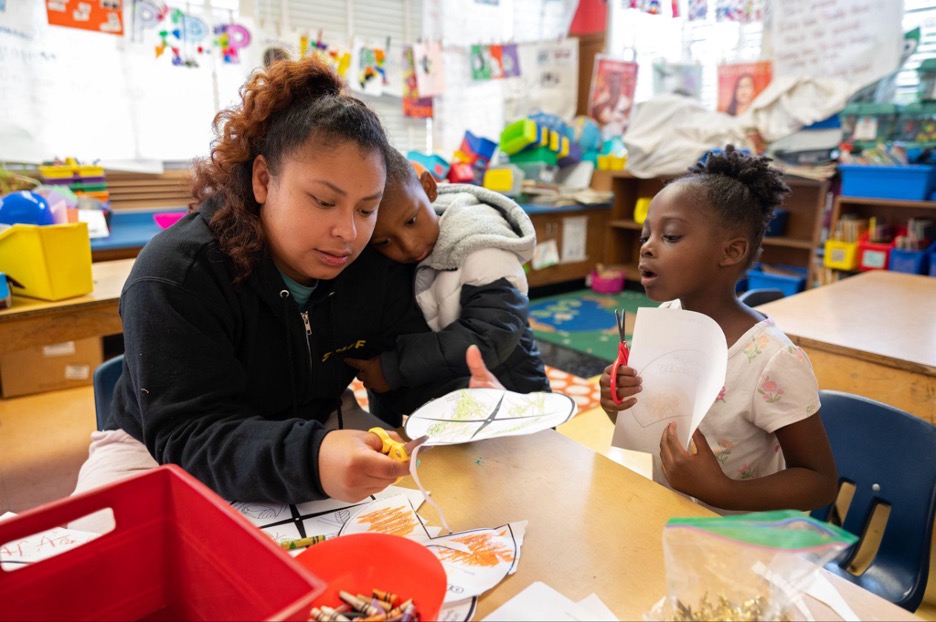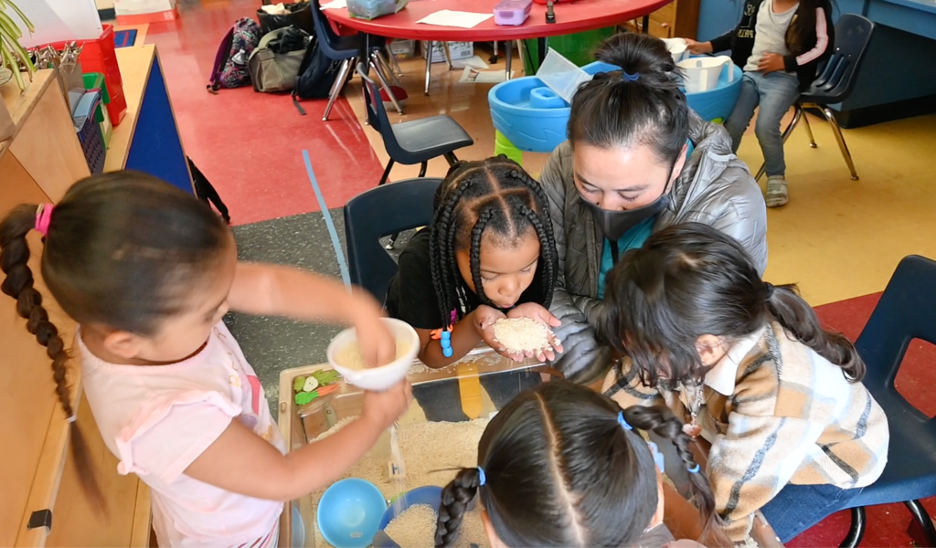
This blog post explores developmentally appropriate practice, a core tenet of early childhood education.
Author Emily Grunt explores the history of the term and provides examples of developmentally appropriate practices in action.
What is developmentally appropriate practice?
Developmentally appropriate practice in early childhood education is a set of guiding principles for practitioners who work in early learning and care environments.
Based on years of research into human brain development, including cognitive, executive function, social-emotional, and critical thinking skills, the definition has expanded with new research into how learning and growth are affected by social and cultural contexts.
Effective early childhood educators have insight as to where the children in their care lie in their particular phase of growth and create thoughtful plans to meet them at their level of development, taking in their unique individual qualities and life background to provide the “just right” challenges that help them grow.
Developmentally appropriate practice recognizes and supports each individual as a valued member of the learning community.
NAEYC DAP: Defining Developmentally Appropriate Practice
History: How did we get here?
Participation in public preschool programs began to grow rapidly in the mid-1980s. At that time, National Association of Educators for Young Children (NAEYC) had recently launched its accreditation system for early learning programs, frequently referencing the term “developmentally appropriate.” This was despite the fact that core guidelines on appropriate expectations and practices in early education had yet to be defined, resulting in vastly different interpretations of the term.
NAEYC and Developmentally Appropriate Practice
NAEYC released their position statement on developmentally appropriate practice soon afterwards with the original concentration on 4- and 5-year-olds. Visits to early childhood programs resulted in a quick expansion to encompass children from birth through age 8.
All of these events resulted in an agreed-upon definition of “developmentally appropriate” within the early education field for dissemination to educators, families, policymakers, and others with a vested interest in early child care.
NAEYC’s original position statement receives regular updates and revisions to reflect updated research from the field, correct misunderstandings, and incorporate new science and professional learning.
The latest update intentionally leaves out the term, “best practice” in favor of highlighting the latest evidence and research on quality practices within the early childhood education (ECE).
Acknowledging Bias
“Best practices” were defined in the original statement by the dominant culture at the time—white, middle-class, heterosexual, Protestant people of northern European descent. So eliminating the term “best” is an attempt to counter bias based on cultural assumptions and limited experience with a variety of populations.
Educators who rely on the notion of a single “best” practice often make assumptions based on their own experiences, which may not have involved extensive experiences with a variety of populations.
NAEYC DAP: Defining Developmentally Appropriate Practice/Position Statement
Interactions with and between children in the early childhood environment can be complex due to the diversity of families and the children’s skills, abilities, languages, cultural, and social community norms.
Early childhood educators are tasked with on-the-spot decision-making involving a plethora of inputs and must put aside their own cultural and social assumptions to consider those of their young charges.
As science and research evolve, professional learning is crucial to support early childhood educators in incorporating new understanding into their knowledge base.
Laying the groundwork
Young children thrive and learn best when they have secure, positive relationships with adults who are knowledgeable about how to support their development and learning and are responsive to their individual progress.
Transforming the Workforce for Children Birth Through Age 8: A Unifying Foundation Washington (DC): National Academies Press (US); 2015 Jul 23.
Building bonds with children using sensitivity and responsiveness and forming positive relationships that foster trust and mutual affection is an essential component of developmentally appropriate practice. In addition, appreciating the differences in each child along with the particular advantages or challenges these differences present offers the educator greater opportunity for meaningful connection.
Individualized activities are based on a child’s age and stage of development. When educators understand the general stages of learning they are able to apply developmentally appropriate practices on an individual basis.
A knowledge and understanding of the milestones and sequences of child development as well as the individual child’s abilities and needs, cultural, and social environment helps the educator provide meaningful experiences.
Dr. Rudine Sims Bishop, professor emerita of education at The Ohio State University, has been called the “mother of multicultural literature” and brought the education world to attention with her essay, Mirrors, Windows and Sliding Glass Doors.
Books are sometimes windows, offering views of worlds that may be real or imagined, familiar or strange. These windows are also sliding glass doors, and readers have only to walk through in imagination to become part of whatever world has been created or recreated by the author. When lighting conditions are just right, however, a window can also be a mirror.
Dr. Rudine Sims Bishop in the journal Perspectives: Using and Choosing Books for the Classroom
Educators can use the windows and sliding glass doors analogy to open children to new peoples, families, experiences, and ideas, present and past, using books, toys, pictures, posters, musical instruments, textiles, and other representations of cultures from around the world.
Using the mirror analogy, educators can create multicultural classroom environments that are reflective of many different types of families and backgrounds.
Developmentally appropriate practice in action: What does it look like?
Teaching practices build on each child’s multiple assets and actively counter various forms of bias. Through their intentional teaching, educators blend opportunities for each child to exercise choice and agency within the context of a planned environment constructed to support specific learning experiences and meaningful goals.
NAEYC DAP: DAP: Teaching to Enhance Each Child’s Development and Learning
Consistency and predictability establish connection and trust. Surrounding children with environments that are safe, visually attractive, and child-size provide stability and form “roots” upon which children can depend.
Using daily routines along with regular rituals throughout the days, weeks, and years provides a solid foundation and a sense of safety and trust. Likewise, modeling reading and writing behavior and fostering a child’s interest through active listening and opportunities for doing will help them develop a sense of accomplishment and positive self-image.

Within these predictable, safe, relationship-based environments, educators can provide a multitude of ways to connect and ensure children receive a strong foundation in early literacy skills.
Examples include:
- Singing songs to ease transitions to mealtimes, indoor/outdoor environment shifts, bathroom time, etc.
- Daily reading, including a wide variety of stories reflecting multiple cultures and backgrounds
- Poetry where phonemic patterns like rhyme and alliteration are central
- Responsive conversations with time for deep listening and reflection
- Finger plays and games that involve both small and large muscle movement
- Dramatic play such as grocery stores where children can create lists and prices
Conclusion
Developmentally appropriate practice is dependent upon the educator creating a warm, positive, and encouraging relationship with each child they serve, while celebrating and honoring classroom diversity and ensuring equitable opportunity for every individual.
Early childhood educators have a special responsibility to remain current in their field and incorporate the latest research into their knowledge base.
Participation in professional learning programs that reflect new understandings of brain development and its effect on social, emotional, and linguistic development can help early childhood educators with ways to develop bonds with children while simultaneously providing a supportive community familiar with the myriad challenges endemic within the profession.
Explore SEEDS of Learning
Professional Learning Framework for Adults Who Care for and Teach Young Children
Related:
Meet Kate Horst, Author of SEEDS of Learning™
Expanding Impact from Birth through Grade 8: Why Collaborative Classroom and FluentSeeds Are Merging
